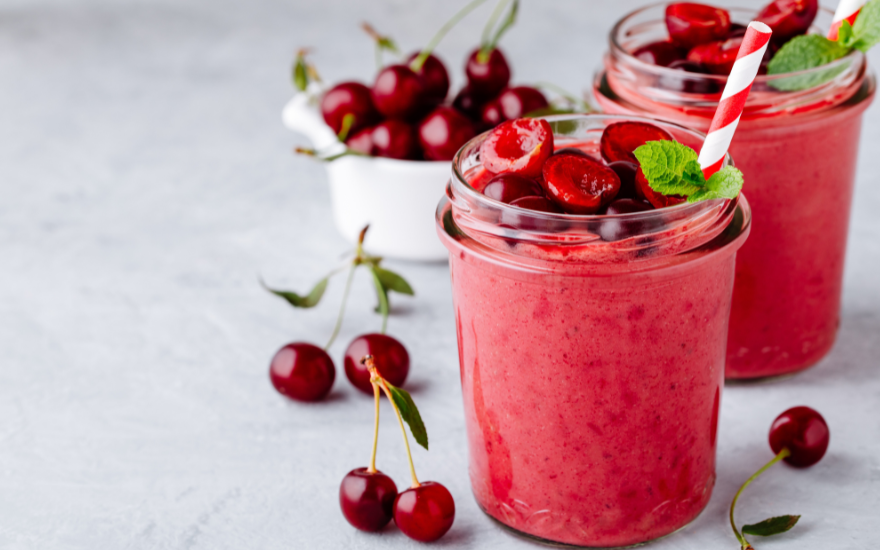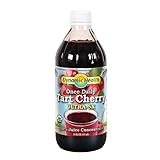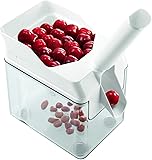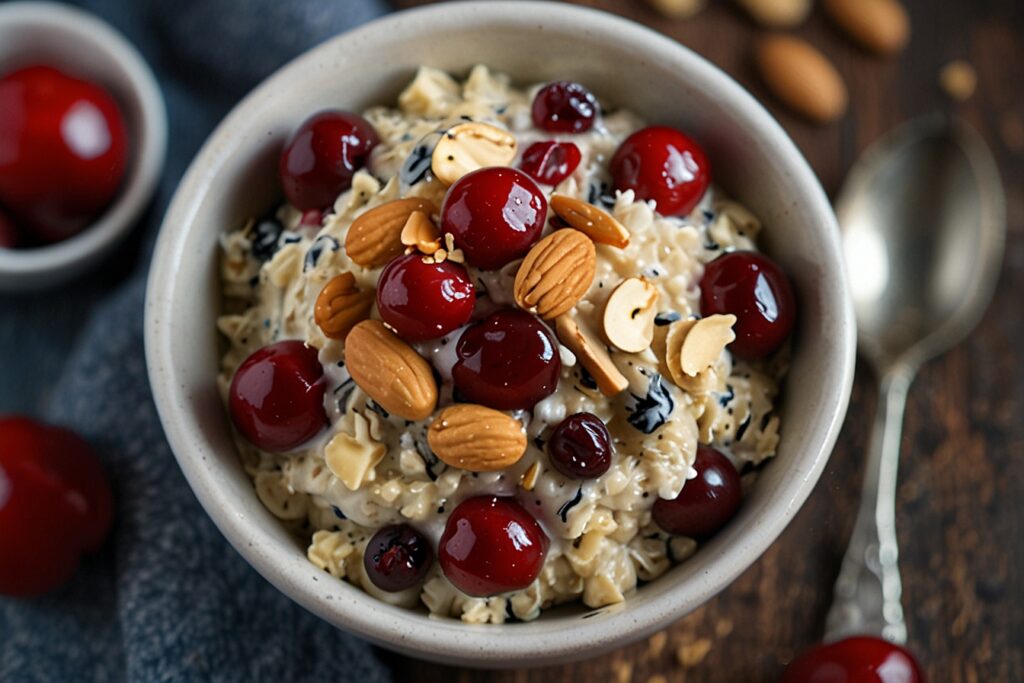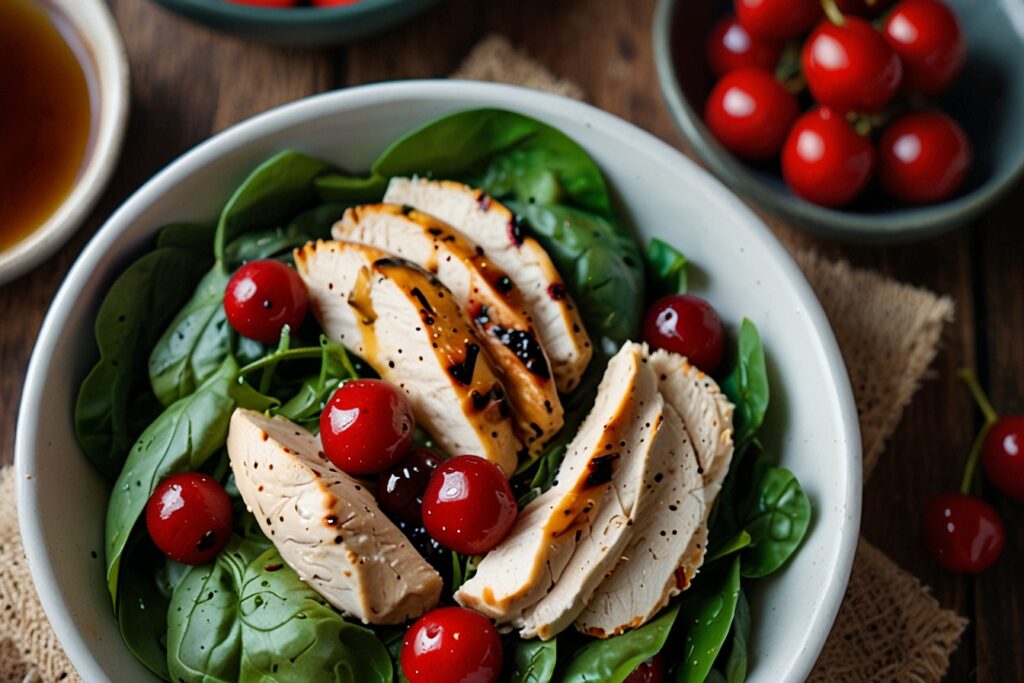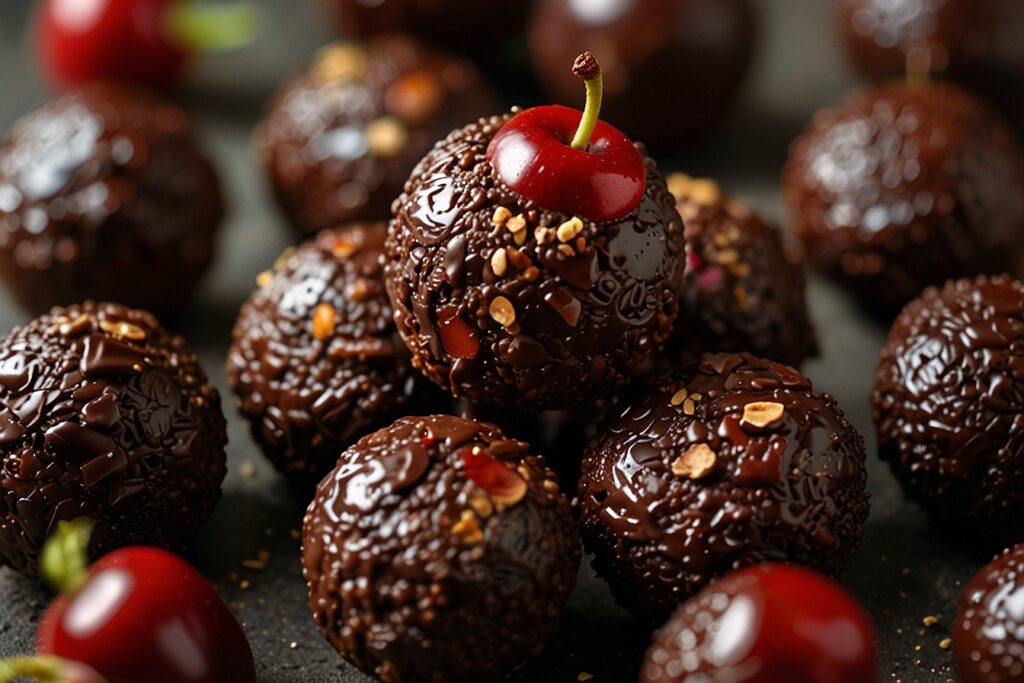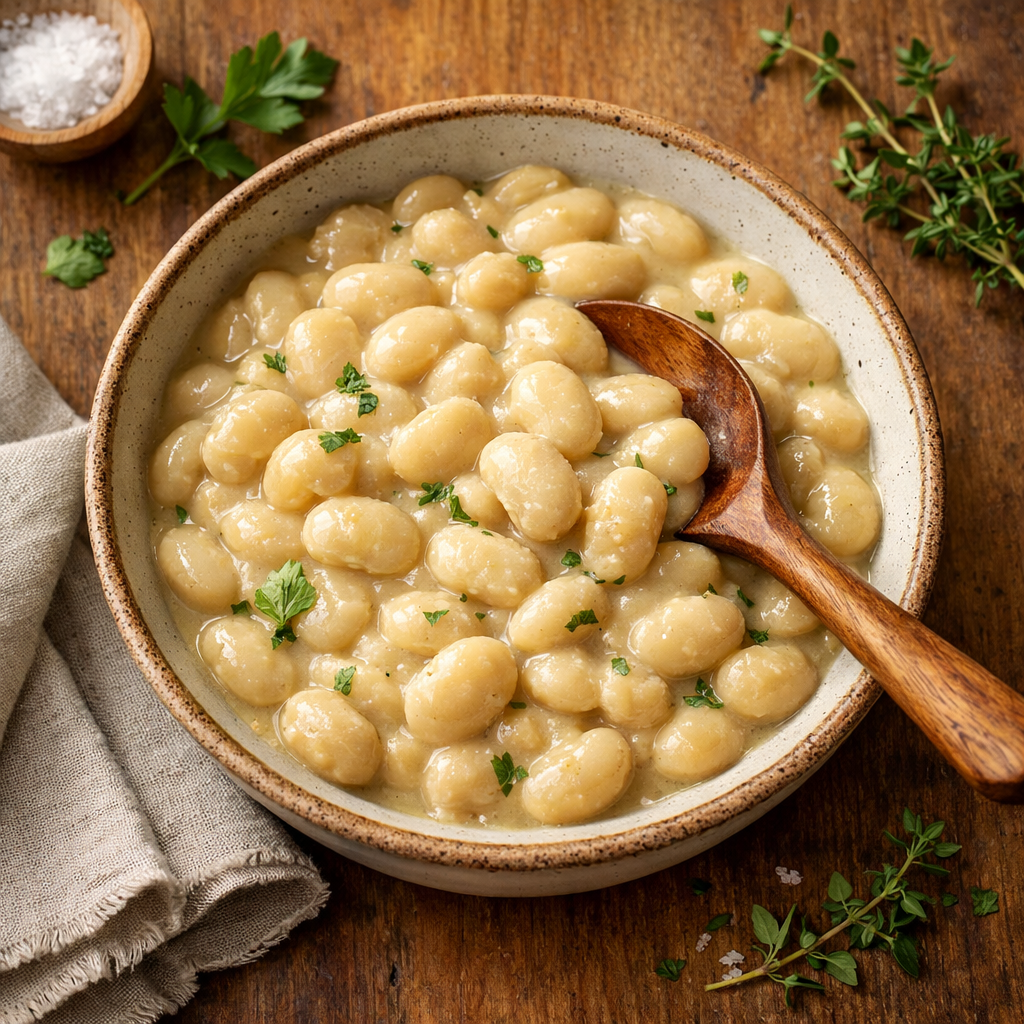Growing up, I always thought cherries belonged in my favorite desserts – cheesecakes, pies, and homemade jams. I’d also discovered the magic of adding cherry to my home-brewed iced tea blends – mixing it with other fruity flavors created this amazing, refreshing drink that I absolutely loved. That was until I stumbled upon the viral sensation of Sofia Richie’s Sweet Cherry Smoothie from Erewhon, priced at a whopping $21!
My curiosity got the better of me, and I decided to create my own version at home. While it might not be an exact replica of Sofia’s famous drink, I’m proud to say my version is not only more budget-friendly but also packs a bigger nutritional punch. This happy accident led me down a path of discovering how versatile and beneficial cherry smoothies can be. Let me share everything I’ve learned about creating these amazing drinks.
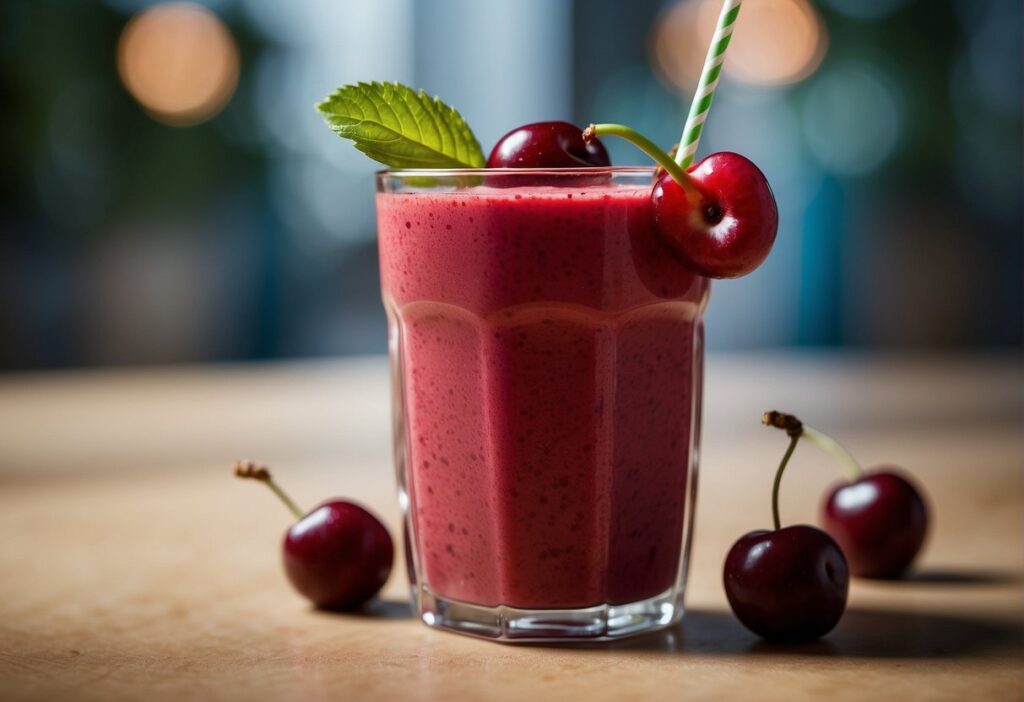
My Cherry Smoothie Discovery
After seeing Sofia’s viral smoothie all over social media, I decided to experiment with making my own version at home. Like many others, I started with the basics – strawberries and bananas – trying to figure out the right blend. But when I added cherries to the mix, everything changed. That sweet-tart flavor wasn’t just delicious; it brought something special to my morning routine that I hadn’t experienced before.
My first attempt was far from perfect. I’d grabbed some cherries from the farmers’ market, planning to make another pie, but decided to try them in my smoothie instead. Armed with just cherries, yogurt, and a drizzle of honey, I created something that, while not quite Erewhon-level fancy, was surprisingly good. This simple experiment sparked my curiosity to learn more.
As I dove deeper into the world of cherry smoothies, I discovered they could help with my ongoing struggles with poor sleep and post-workout recovery. A nutritionist friend explained how different cherry varieties could target specific health goals. This insight opened up a whole new world of possibilities.
Through months of experimentation, I learned to appreciate the unique qualities of different cherry varieties. Sweet cherries like Bing and Rainier create that perfect breakfast blend balance, while tart cherries like Montmorency became my go-to for post-workout recovery drinks. What started as an attempt to recreate a trendy $21 smoothie turned into a passion for crafting healthy, affordable, and delicious cherry-based drinks that actually support my wellness goals.
Why I Love Using Cherries in My Smoothies
What started as an attempt to recreate a trendy smoothie turned into an exciting discovery of cherries’ amazing benefits. While I loved cherries in my desserts and iced tea blends, I never realized their full potential until I started researching why Sofia’s smoothie was such a hit. Through my own experience and research, I discovered that cherries pack an incredible nutritional punch that goes way beyond their sweet taste.
Now, every time I blend these ruby-red gems into my smoothies, I’m getting so much more than just a delicious drink. The benefits I’ve discovered have made me fall in love with cherry smoothies even more than the original Erewhon version:
- A natural source of vitamins C and A, which support my immune system
- Powerful antioxidants that help fight inflammation in my body
- Melatonin, which helps me sleep better at night
- Compounds that aid in muscle recovery after my workouts
If you’re looking to elevate your cherry smoothies with a powerful and nutritious ingredient, look no further than Dynamic Health Organic Tart Cherry Ultra 5x Juice Concentrate. This premium, unsweetened concentrate is packed with antioxidants and natural goodness, making it the perfect addition to your smoothie recipes.
- Pure: Not watered down a powerful elixir, our Tart Cherry juice is pure 100% Juice Concentrate
- Choose Organic: With no sweeteners, preservatives or other additives. USDA Certified Organic
- Tasty: Adds a delicious & healthy flair to smoothies, fruit cocktails, yogurt, ice cream & more
- Quality: Vegan, Gluten-Free, Halal & Kosher. No expense is spared in the quality of our products
The Science Behind My Cherry Obsession
Let me share what I’ve learned about the incredible benefits of cherries. My morning smoothies now pack more punch than just great taste:
Muscle Recovery Magic
After intense workouts, I noticed less muscle soreness when drinking cherry smoothies. Research backs this up – the natural compounds in cherries work like nature’s ibuprofen, but without the side effects.
Sleep Support
My evening cherry smoothies have become part of my bedtime routine. The natural melatonin in cherries helps me drift off more easily. I’ve noticed a real difference in my sleep quality since making this change.
Heart Health Hero
Adding cherries to my diet has helped maintain healthy blood pressure levels. The potassium content makes them a natural ally for cardiovascular health.
My Go-To Cherry Smoothie Recipes
1. The Classic Cherry Breakfast Blend
- 2 cups frozen cherries (I use my trusty Leifheit 37200 Cherry Pitter for fresh cherries)
- 1 banana
- 1 cup almond milk
- 1/2 cup Greek yogurt
- 1 tablespoon honey
- 1/4 teaspoon vanilla extract
Blend until smooth and creamy. This breakfast keeps me full until lunch!
2. Post-Workout Cherry Recovery Smoothie
- 2 cups cherries
- 1 scoop vanilla protein powder
- 1 cup coconut water
- 1/2 cup spinach
- 1 tablespoon chia seeds
- Ice as needed
Perfect for replenishing nutrients after exercise.
3. Cherry-Berry Sleep Support Smoothie
- 1 cup cherries
- 1 cup mixed berries
- 1 cup chamomile tea (cooled)
- 1/2 cup vanilla yogurt
- 1 tablespoon almond butter
- 1/4 teaspoon cinnamon
I drink this 2 hours before bedtime for better sleep.
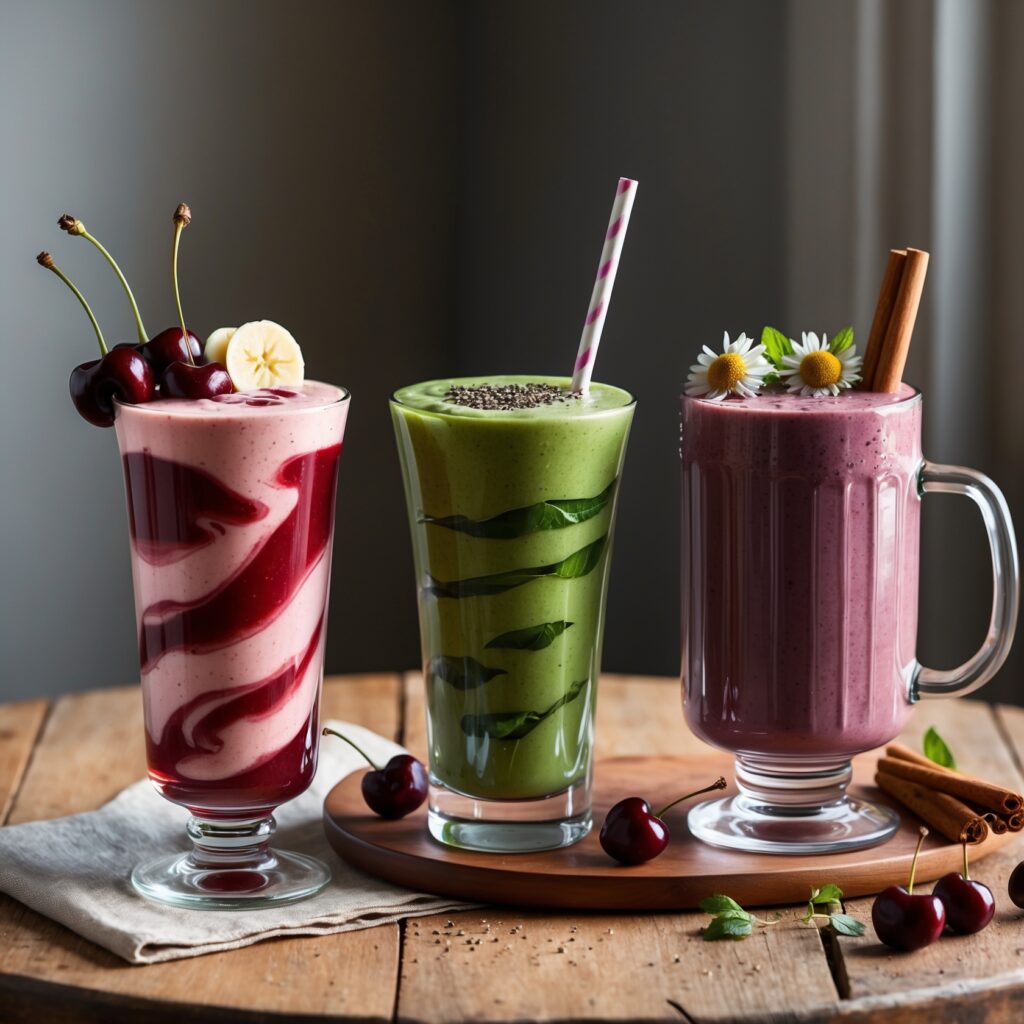
My Smoothie-Making Evolution
When I first started, I used a basic blender that left chunks of frozen fruit and never quite achieved that perfect consistency. For creating smooth and delicious cherry smoothies, the Hamilton Beach Power Elite Blender is an excellent choice. Its powerful motor and Wave Action system ensure thorough blending of cherries and other ingredients, resulting in perfectly textured smoothies every time. It’s been a game-changer for my smoothie texture.
- POWERFUL BLENDING PERFORMANCE: With 700 watts of peak blending power and stainless steel Ice Sabre blades, this smoothie blender gives you all the power you need to make smoothies, protein shakes, frozen drinks and more
- ULTRA-SMOOTH RESULTS WITH PATENTED WAVE ACTION SYSTEM: As you blend, ingredients are continuously forced down into the blades and circulated around the jar — thoroughly crushing the hardest foods with ease
- SERVE WITH EASE: The spout on this electric blender lets you pour contents into your glass without spills or drips, so serving is easy and mess-free
- EASY TO CLEAN WITH DISHWASHER SAFE GLASS JAR, LID AND BLADES: Blending multiple servings is easy with the glass jar that holds 40 ounces; The jar, lid and removable blades on the blender are all dishwasher safe
- 12 BLENDING FUNCTIONS FOR MAXIMUM VERSATILITY: This multi-function blender has 12 functions controlled by 5 simple buttons on the easy-to-read control panel; It blends and crushes ice for smoothies and milkshakes, purees, dices, chops and more
The Art of Cherry Selection
I’ve learned that not all cherries are created equal when it comes to smoothie-making. Here’s what I look for:
Fresh Cherries
When they’re in season, I buy them in bulk. Look for:
- Firm, shiny skin
- Deep color
- Green, flexible stems
- No bruising or soft spots
Frozen Cherries
For year-round smoothies, I stock up on frozen cherries. They’re:
- Already pitted
- Flash-frozen at peak ripeness
- Perfect for creating thick, cold smoothies
- Often more economical
My Kitchen Tools Arsenal
Over time, I’ve built up my collection of essential smoothie-making tools:
- A powerful blender (my Hamilton Beach is a workhorse)
- To make your cherry smoothie preparation quick and effortless, the Leifheit 37200 Cherry Pitter is an excellent tool.
This efficient pitter removes cherry stones cleanly and easily, saving you time and ensuring your smoothies are free from pits. Its design allows for comfortable use and easy cleaning, making it a great addition to any smoothie enthusiast’s kitchen.
- HAND OPPERATED cherry pit remover with stainless steel plunger
- DISHWASHER SAFE container catches all of the seeds from the cherry pit tool
- SAVES TIME: Prep your cherries quickly and easily
- EASY PREP for your canning, baking, preservatives and much more
- 10.5 inch H x 4.5 inch W x 6 inch D
- Measuring cups and spoons
- Freezer-safe containers
- Reusable straws
- Travel cups for on-the-go smoothies
Tips From My Kitchen to Yours
After countless smoothies and many early morning experiments, here’s what I’ve learned. These tips come from years of trial and error, countless taste tests with family and friends, and my personal quest to create the perfect cherry smoothie for every occasion and need.
My Personal Smoothie Ritual
Each morning, I start by gathering my ingredients mindfully. I’ve learned that rushing through the process often leads to forgotten ingredients or improper measurements. I take a moment to arrange everything on my counter, check my frozen fruit supply, and ensure my blender is clean and ready. This morning ritual has become a peaceful way to start my day.
Mindful Measuring and Mixing
One of my biggest early mistakes was eyeballing ingredients. Now I know that precise measurements make a huge difference in consistency and taste. I start with my frozen ingredients, add my liquids, then top with any boosters like protein powder or supplements. This layering technique helps everything blend smoothly and prevents powder from sticking to the sides of the blender.
After countless smoothies, here’s what I’ve learned:
Preparation Tips
- Frozen cherries create the best texture – I always keep some in my freezer
- Adding a banana makes the smoothie creamier
- Start with less liquid and add more as needed
- Plant-based milk alternatives work great if you’re dairy-free
- A tiny pinch of salt brings out the cherry flavor
Organization Tips
- Prep smoothie packs in advance
- Keep frozen fruit at the front of your freezer
- Clean your blender immediately after use
- Store frequently used ingredients together

Making Your Smoothie Work for You
Through trial and error, I’ve found ways to customize cherry smoothies for different needs. My smoothie experimentation journey has taught me that personalization is key. Each person’s body responds differently to ingredients, and what works perfectly for one might not suit another. I’ve spent countless hours adjusting recipes based on feedback from family members, friends, and my own body’s responses.
Understanding Your Body’s Needs
Before diving into customization, I learned to pay attention to how different ingredients affect my energy levels, digestion, and overall well-being. I kept a smoothie journal for three months, noting my reactions to different combinations. This helped me create targeted recipes for specific needs.
Perfect Timing: When to Drink Your Smoothies
Here’s something I wish I’d known from the start—when you drink your smoothie matters just as much as what goes into it. Through my daily experiments, I’ve cracked the code on the best times to enjoy different types of cherry smoothies.
I learned this by accident when I once had my post-workout smoothie two hours after exercising—it didn’t give me the same energy boost I was used to. Now I make sure to sip my recovery blend within that golden 30-minute window after my workout.
As for my sleep-support smoothie, I found my sweet spot two hours before bedtime—just enough time for my body to process the nutrients and help me drift off naturally. These aren’t just random times; they’re windows I’ve discovered through months of paying attention to how my body responds.
Weight Management
- I use unsweetened almond milk
- Skip added sweeteners
- Add extra protein powder
- Include leafy greens
- Track portions carefully
Better Sleep
- I make my smoothie 2 hours before bedtime
- Use tart cherries
- Add magnesium-rich ingredients like spinach
- Include calming herbs like chamomile
- Avoid stimulating ingredients
Workout Recovery
- I double the protein
- Add electrolytes through coconut water
- Include anti-inflammatory ingredients like ginger
- Mix in some tart cherry juice concentrate
- Time it right after exercise
Here are some other yummy ideas on how to include cherries in your diet
Seasonal Adaptations
I’ve learned to adapt my cherry smoothies throughout the year:
Summer Variations
- Add extra ice
- Include cooling ingredients like mint
- Use frozen cherries instead of liquid
- Make popsicles from leftover smoothies
Winter Warmth
- Use room temperature fruit
- Add warming spices like cinnamon
- Include ginger for extra heat
- Blend with warm tea instead of cold liquid
Troubleshooting Common Issues
Here’s how I’ve solved common smoothie problems:
Too Thick?
- Add liquid gradually
- Use room temperature ingredients
- Blend longer
- Adjust fruit-to-liquid ratio
Too Thin?
- Add more frozen fruit
- Include a thickener like chia seeds
- Use less liquid
- Add ice cubes
Not Sweet Enough?
- Add a ripe banana
- Include dates
- Mix in sweeter fruits
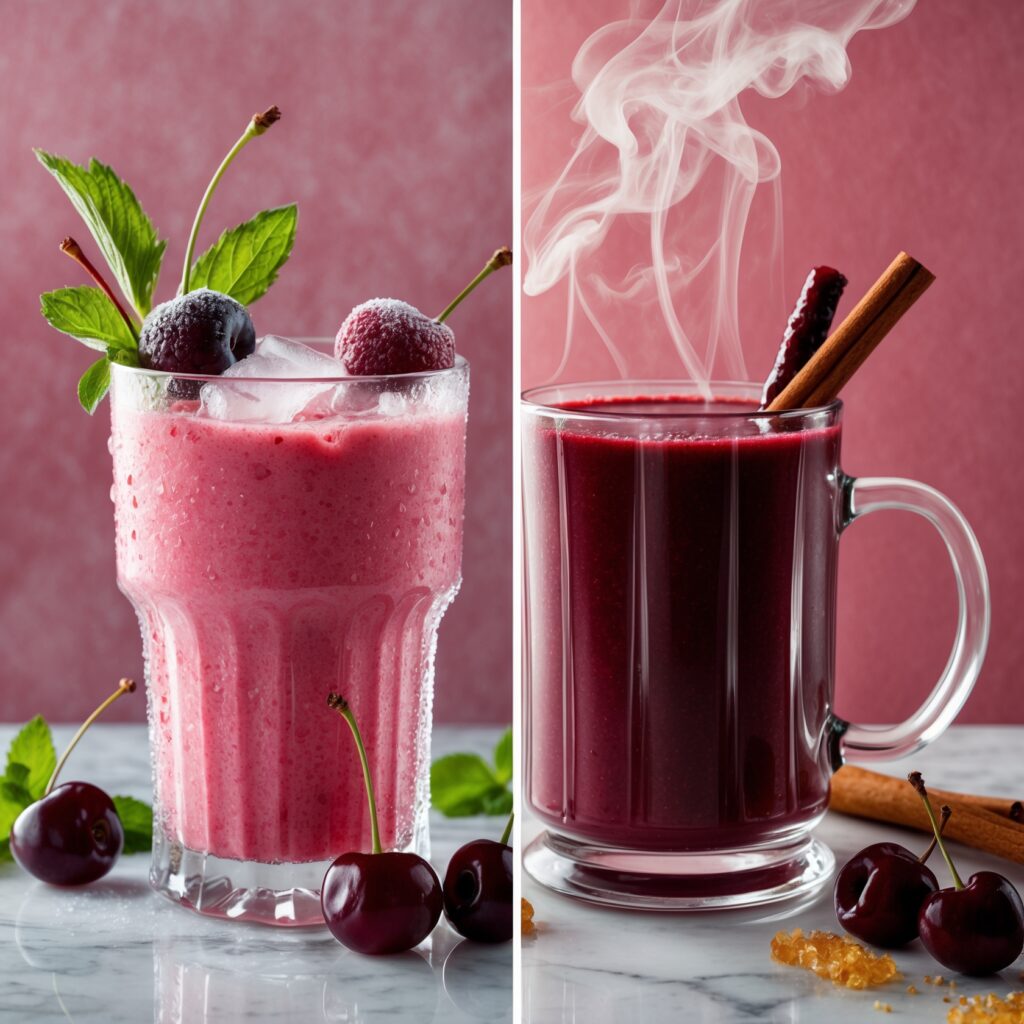
My Natural Sugar Management Approach
I’ve learned to manage the sugar content in my smoothies by:
- Using tart cherries
- Adding protein and healthy fats
- Incorporating vegetables
- Avoiding additional sweeteners when possible
- Balancing with fiber-rich ingredients
Storage Solutions I’ve Discovered
If I make extra smoothie, I make sure to:
- Store it in an airtight container
- Fill it to the top to minimize air
- Keep it in the fridge for up to 24 hours
- Shake well before drinking
- Pour into smaller portions
Cost-Saving Strategies
Making cherry smoothies doesn’t have to break the bank. Here’s how I save:
- Buy cherries in season and freeze
- Purchase frozen cherries in bulk
- Use sales and coupons
- Make my own nut milk
- Grow herbs at home
Environmental Considerations
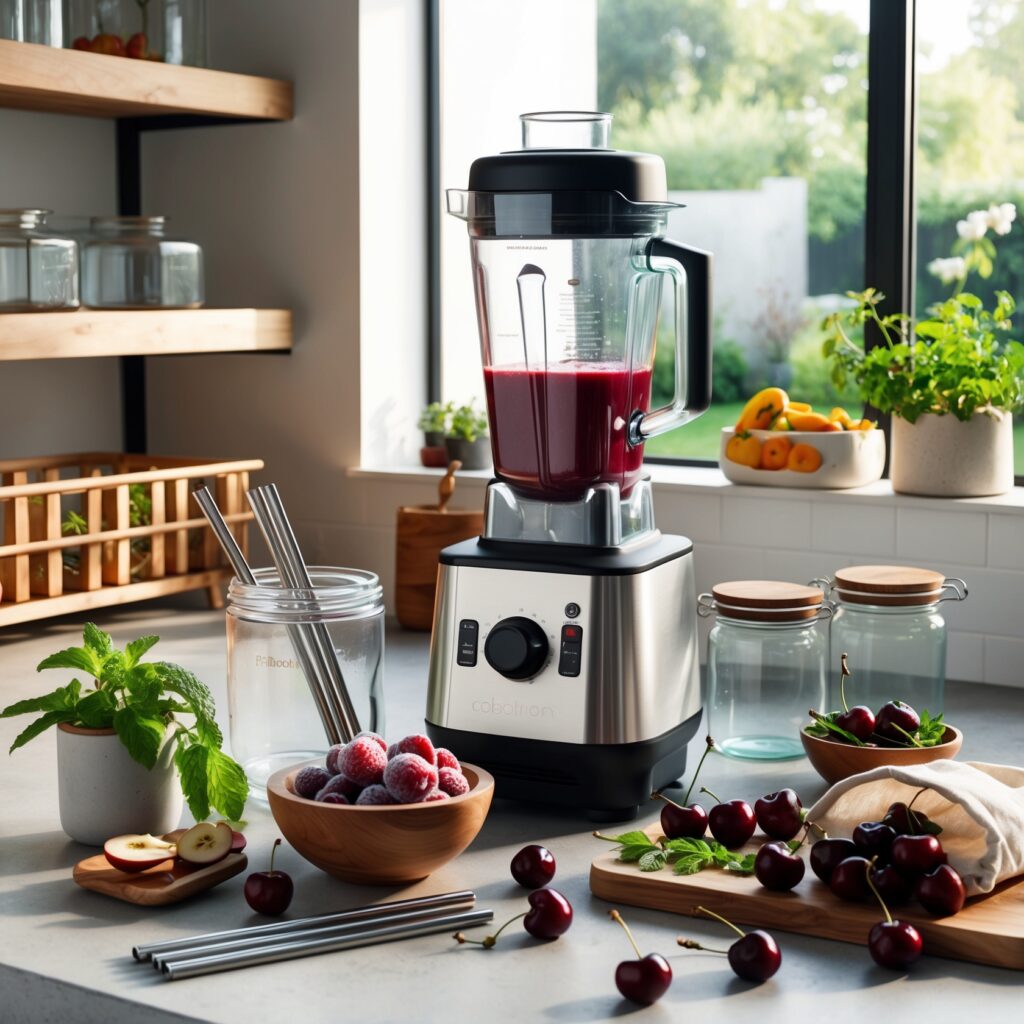
I try to make my smoothie habit eco-friendly by:
- Using reusable straws
- Composting fruit waste
- Buying local when possible
- Reducing plastic packaging
- Using glass containers
Advanced Smoothie Techniques
Over the years, I’ve developed some advanced techniques that take my cherry smoothies to the next level:
Layering for Perfect Texture
I’ve learned to layer ingredients in a specific order: liquids first, then soft fruits, followed by frozen fruits and ice. This method ensures smooth blending and prevents the dreaded chunks of unblended fruit.
Temperature Control
Through experimentation, I’ve found that the temperature of ingredients significantly affects the final texture. Room-temperature bananas blend smoother than frozen ones, and slightly thawed cherries release more flavor than rock-hard frozen ones.
Creative Boosters
I love adding unexpected ingredients to enhance nutrition and flavor. Some of my favorites:
- Raw cacao nibs for antioxidants and crunch
- Hemp seeds for omega-3s
- Butterfly pea powder for natural blue color
- Beet powder for extra nutrients
Smoothie Meal Prep Strategies
My busy schedule led me to develop efficient meal prep strategies:
Weekly Prep Sessions
Every Sunday, I portion out ingredients for the week ahead. I create smoothie packs with pre-measured frozen fruits and add-ins, making morning preparation quick and easy.
Smart Storage Solutions
I’ve learned to store different ingredients properly to maintain freshness:
- Greens wrapped in paper towels to absorb excess moisture
- Frozen fruits in vacuum-sealed bags to prevent freezer burn
- Nuts and seeds in airtight containers in the fridge
Final Thoughts
My cherry smoothie journey has taught me that these drinks can be so much more than just tasty beverages. They’ve become a daily ritual that nourishes my body and brings joy to my mornings. Through experimenting with different combinations and learning about the health benefits, I’ve discovered a passion for creating nutritious and delicious smoothies that support my overall wellness goals.
The beauty of this journey lies in its endless possibilities for creativity and personalization. Every smoothie tells a story—of morning rushes turned into mindful moments, of post-workout recovery celebrations, of peaceful evening wind-downs. My blender has become more than just a kitchen appliance; it’s a tool for daily self-care and nutrition.
One of my biggest learnings has been that while taste is wonderful, the true value of a smoothie lies in its nutritional content. You can always adjust flavors with natural sweeteners or spices, but you can’t enhance the nutritional benefits after the fact. That’s why I always encourage focusing first on including ingredients that serve your body’s needs, then tweaking the taste to your liking. After all, what good is a delicious smoothie if it doesn’t nourish you from within?
I’ve learned that the perfect smoothie is different for everyone, and that’s the beauty of it. Whether you’re looking to boost your workout recovery, improve your sleep, or simply enjoy a healthy treat, there’s a cherry smoothie recipe that’s right for you.
I’d love to hear about your cherry smoothie adventures—what combinations have you tried? What works best for you? Remember, there’s no one-size-fits-all approach, and that’s what makes this journey so exciting. Keep experimenting and find what makes your taste buds happy!
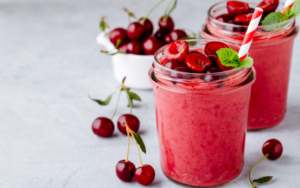
*We may earn a commission for purchases made using our links. Please see our disclosure to learn more.

